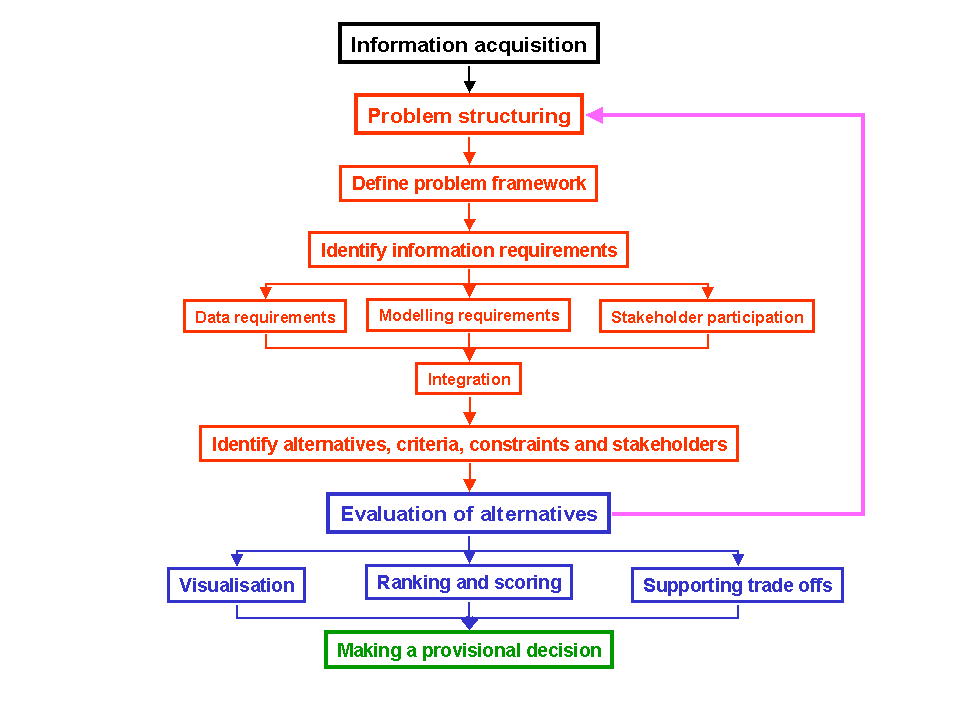
2. WHAT IS MEANT BY DECISION SUPPORT SYSTEM?
There are a broad variety of frameworks, protocols, processes, methods, tools and models, that have been defined as Decision Support Systems (DSSs) for integrated water resource management in South Africa and around the world (Stewart et al., 2000).
Each DSS is specifically designed to provide the decision maker with a set of information that will enhance their decision-making capabilities. Most DSSs are therefore designed around the problem they are trying to solve, the concern they are attempting to address or the question they wish to answer and only represent a small subsection of the overall generic decision-making process.
The purpose of a DSS is, therefore, a function of
The success of a specific DSS is therefore dependent on its ability to solve the problem it is being used to address at the required scale and the extent to which it can support the decision making process. It is therefore crucial when designing any DSS to define the needs that the user is trying to fulfil at the scale at which the solution / solutions need to be addressed.
In the context of this review the DSS will be analysed in its ability to support the SEA in its objective of developing an overall framework approach to ensure South Africa’s water resources are utilised optimally in the short and long term to the best benefit of the people and environment of South Africa.
The main objective of the DWAF SEA team is to develop and test a replicable, participatory and affordable methodology for incorporating strategic environmental assessment into decision-making regarding water use at a National scale, scale of WMA and a local area scale. In this project the definition of a decision support system will be formulated in terms of a system that will provide the information required to service water managers at the Catchment Management Agency (CMA) level in terms of the NWA established in 1998. The CMA scale was chosen because of the challenges faced at an operational level in Water Management Areas (WMAs) in order to meet the requirements of Section 27 of the NWA (1998). It is also possible to use the techniques developed at the lower scale to produce information that can be aggregated and summarised and used in decision making at a higher level within DWAF and other state institutions.
The DSS proposed in this document attempts to address the criteria laid out in S27. The provisions in S27 have influenced the design of the proposed SEA DSS.
Stewart et al. (2000) have suggested that the following stages, processes and activities represent the generic decision-making process:
Jewitt and Görgens (2000) looked at DSSs from an ICM perspective where they defined DSSs as computer based information systems, where tools representing an extensive set of capabilities are integrated to provide decision support to managers and stakeholders. In order for such computer based tools / systems to provide realistic and useful information they need to combine several sources of information or databases, more than one problem representation or model and a multifaceted and problem orientated user interface, in a common framework. Jewitt and Görgens (2000) identified the large number of definitions of DSSs and, hence for the purpose of their project, DSSs are considered as software systems that facilitate management through the integration of three types of information, namely
Figure 1 is a representation of the combined definition of the decision making process outlined by Stewart et al. (2000) and the definition of a DSS according to that of Jewitt and Görgens (2000). In this document Figure 1 will be used to as the framework upon which the DSS to support the SEA in the implementation of the New NWA (1998) will be designed.

Figure 1 Schematic representation of the decision making process (adapted from Jewitt and Görgens, 2000 and Stewart et al., 2000)